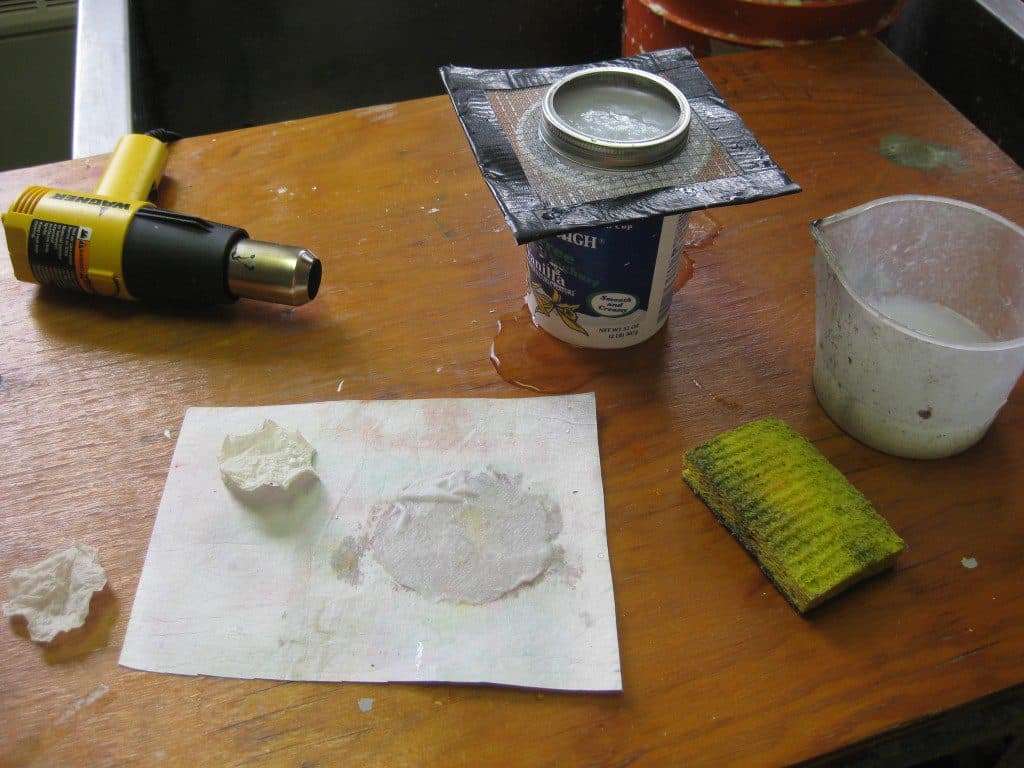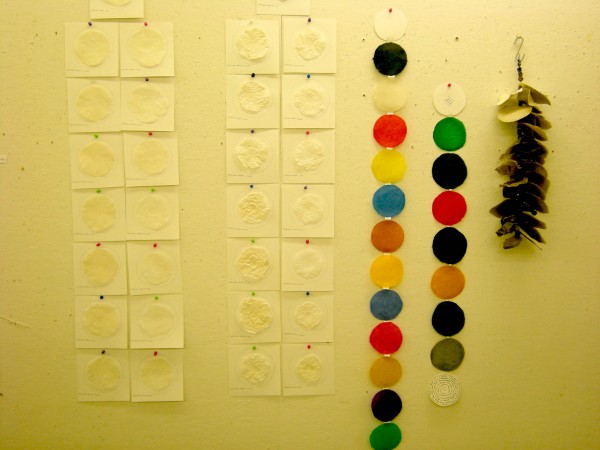Tin Can Papermaking
Replication in the papermaking process can be challenging. I’ve made overbeaten abaca pulp for the past 15 years, but I still have to make a test sheet to ensure that the pulp is translucent enough and shrinks the way I like it to. Better safe than sorry (and I speak from experience).
When I think the pulp is finished beating – this takes about 3 hours in my Reina beater, but could take up to 8 hours in my old Davis Hodges beater – I make a small sample sheet. By look and feel, the pulp changes in consistency and takes on a slimier quality, but I can’t be sure by sight that it will be translucent to my liking. It also drains quite slowly when overbeaten.

I think Arnold Grummer coined the term “tin can papermaking” and it is a brilliant idea. I use it for making test sheets: I take a small amount of pulp out of the beater, add some water and pour it through a small screen that sits on top of a yogurt container. My screen is a double layer of 1/4″ hardware cloth and window screen, duct taped around the edges. You can see here that I used the top of a mason jar as my deckle, but a cookie cutter will do the trick too.

Look at these adorable tin can critters from Arnold Grummer’s Papermaking Kits & Supplies
Once the pulp has drained, I couch it onto a piece of pellon or felt, sponge out the excess water and then quick-dry it with a blow dryer or heat gun. Then I can see how it will look when air dried, which is usually how I’m drying my abaca. If I wanted to see how it would look dried flat (under restraint), I would iron it, although abaca shrinks when it is ironed too.
In general, I’ve found that abaca that is restraint dried needs to be beaten longer to become translucent – something about restraining it that I don’t understand (science) makes it milkier and whitish.
When I taught a papermaking course at Oregon College of Art & Craft, one of my first assignments was to have students do beater and color tests, and they used the tin can papermaking technique!

OCAC student test sheets: abaca and cotton linter beating time tests; color tests; creative display of test sheets
I’m curious how you use tin can papermaking, or how you make test sheets. Please leave a comment below!
If you’d like more information on papermaking techniques, you can check out my books and videos. I’ll even send you an autographed copy!
_______________________________________________________________________________
The Papermaker’s Companion covers every imaginable aspect of creating one-of-a-kind papers and using those papers in fun, creative, and beautiful ways.
Papermaking with Garden Plants & Common Weeds describes how to collect, harvest, and process the plant fibers and then create sheets using both Western and Japanese techniques.
Water Paper Time uses time-lapse photography to explore how external forces such as time, gravity and molecular structure bend, tear and wrinkle handmade paper, producing startlingly allusive and organic forms which recall the fibers and plants that the artist used in the paper-making process. Click here to watch the trailer.
The Papermaker’s Studio Guide DVD is a visual guide to hand papermaking based on my book, The Papermaker’s Companion, showing hand papermaking in action. Click here to watch the trailer.


3 Comments
Helen, thanks so much for the beautiful use and write-up of Dad’s ‘Tin Can Papermaking’ method. He came up with TCP for the first chapter of ‘Paper By Kids’ (Dillon Press, Mnpls). The editor told him he had to have a way for kids to successfully make paper with things around the house in the first chapter. So he did.
Very interesting that you use TCP for test sheets. Dad developed Tin Can Papermaking and the ‘pour’ method Papermill handmold based on the British Hand Sheet Former used by scientists at the Institute of Paper Chemistry for testing paper samples.
Love your image of test sheets and color samples. Absolutely as compelling as Tin Can Critters!
Kind regards, Kim
[…] This post by paper-maker Helen Hiebert has a clear photograph of a tin-can set-up. […]
[…] wrote this blog post about how I use the technique to create test sheets. You’ll see a picture of my tin can […]